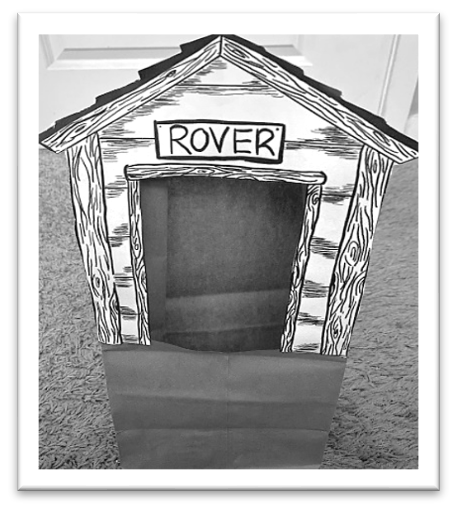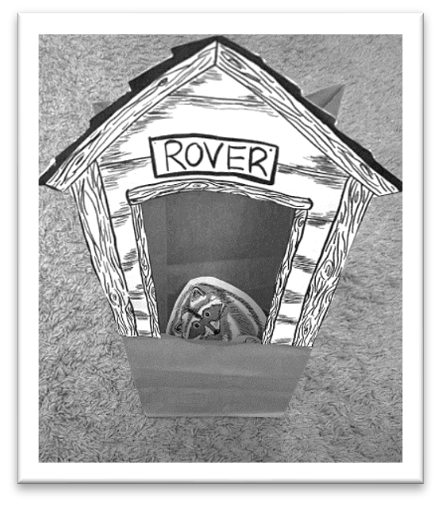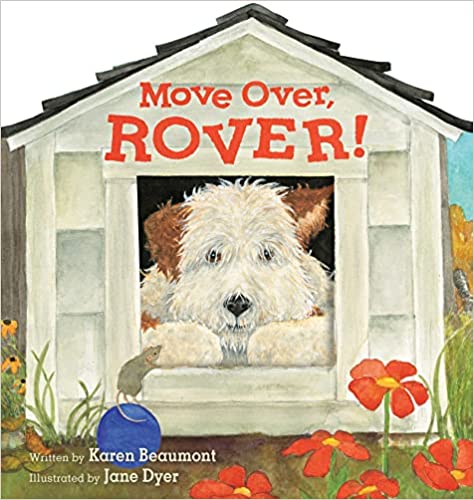Interactive Literacy Activity (ILA): Retelling with Puppets
OVERVIEW
Encourage collaborative storytelling and foster creativity and shared storytelling by using puppets to retell Move Over, Rover!
TIME TO COMPLETE
30 minutes
ILA LESSON OBJECTIVES
At the end of this lesson, participants will be able to:
- Analyze a text to understand how the author uses predictable text to support early literacy; and
- Use Move Over, Rover! by Karen Beaumont as inspiration for creative play.
NELP PREDICTORS OF LATER SUCCESS
print knowledge: a combination of elements of alphabet knowledge (AK), concepts about print, and early decoding;
reading readiness: usually a combination of AK, concepts of print, vocabulary, memory, and phonological awareness.
ELPS ANCHOR AND LEVEL CORRESPONDENCES
ELP Standard 9: An ELL can create clear and coherent level-appropriate speech and text.
Level 1: By the end of English language proficiency level 1, an ELL can with support,
- communicate basic information about an event or topic; and
- use a narrow range of vocabulary and syntactically simple sentences.
Level 2: By the end of English language proficiency level 2, an ELL can with support,
- recount a short sequence of events in order;
- introduce an informational topic; and
- use common linking words to connect events and ideas.
Level 3: By the end of English language proficiency level 3, an ELL can with support,
- recount a sequence of events, with a beginning, middle, and end;
- introduce and develop an informational topic with facts and details;
- use common transitional words and phrases to connect events, ideas and opinions; and
- provide a conclusion.
MATERIALS
- Multiple copies of Move Over, Rover! by Karen Beaumont
- Animal images
- Rover’s doghouse image
- Scissors
- Glue sticks
- Markers or crayons
- Paper bags
- Popsicle sticks (optional)
INTRODUCTION
Puppetry can be a valuable tool for children's language development, storytelling, creativity, and fine motor skills. By working with puppets to reenact a story, children can better understand the narrative structure and its elements (characters, setting, plot, and problem-solution). Additionally, the process of making puppets can enhance children's fine motor skills as they use scissors, glue, and writing utensils. In the parent/caregiver education lesson, participants learned about predictable texts and how they benefit their child's literary skills. Move Over, Rover! by Karen Beaumont is a cumulative story, each time a new event occurs, all the other events are repeated. When children retell a cumulative story, they are not only demonstrating their comprehension of the story, but also developing their ability to sequence events.
To begin, parents/caregivers will read Move Over, Rover! with their child. After reading the book, using basic puppets made from paper cutouts, children will have the opportunity to reenact the tale. The animal and doghouse images provided can be cut out and used as simple puppets. To create the doghouse, cut out the black square to form an opening for Rover, and then attach it to a paper bag using glue. See images below for guidance. Remind families to place the skunk into Rover's doghouse at the start of the story. Extend learning by encouraging families to be imaginative and develop new stories and characters.



INFANT/TODDLER
The rhythm and rhyme within Move Over Rover! can capture even the youngest of audience. However, if attention wanes, feel free to skip pages as the cumulative rhyme will maintain the story. Point to the animals within the illustrations and make their corresponding sounds or tap fingers on the pages to imitate the pouring rain.
After reading, use the animal images to introduce puppetry. Mimic the sounds of the animals and tell a simplified version of Move Over, Rover! together by placing each animal into Rover's doghouse one by one. Use the animal images to act out new stories using animal sounds.
Cut out the animals and doghouse prior to the lesson. Consider attaching the animals to popsicle sticks to make it easier for the child to hold.
Predictable texts are particularly important for toddlers and infants as they are just beginning to develop their literacy skills. Predictable texts help toddlers to develop their phonological awareness, as they begin to notice and predict the sounds and rhythms within the language.
PRE-SCHOOL
Read the book with your child focusing on using interactive reading strategies. Encourage early readers to read the words they know and repeat recurring phrases together.
Next use the animal images to introduce the concept of retelling. Invite children help cut out and attach Rover’s doghouse to the paper bag to help develop their fine motor skills. Talk about the story, name the animals, and mimic their sounds when creating puppets together. Invite children to customize their puppets by using markers or crayons to color. After the bag and puppets are created, reenact the story. Place the skunk in the paper bag first so when all the animals run out, the skunk is still left in the bag. Assist children in retelling the story. Ask them what animal comes next and have them place them in the bag. Have the child sound out or act out each animal as they place it into the doghouse.
Retelling is an important aspect of early literacy development because it helps children to understand and make connections between different stories and texts. Children develop their vocabulary and language skills, as they use new words and phrases to describe the events in the story.
Consider extending the activity by repeating phrases throughout the book as you place the animal into the bag such as “Skit-scat Cat! Move over, Rover!”
SCHOOL-AGE
School-aged children may be able to read to the parent or caregiver. While the child is reading, the parent/caregiver can make the reading interactive by pausing along the way to ask clarification questions or echoing repetitive phrases throughout the book.
Next use the animal images to introduce the concept of retelling. Have the children help cut out and attach Rover’s doghouse to the paper bag to help develop their fine motor skills. Invite students to customize their puppets by using markers or crayons to customize the images. After the bag and puppets are created, reenact the story. Place the skunk in the paper bag first so when all the animals run out, the skunk is still left in the bag. Have the child retell the story going over key details and repeated elements.
Talk about the story: "What might have happened if the skunk had never entered the doghouse?" Encouraging reflection and critical thinking through questions will help solidify the child's understanding of the story.
Retelling stories is a valuable activity for school-age children, as it helps to develop their language and communication skills, as well as their comprehension and understanding of narrative structures. When children retell a story, they are able to practice their listening and speaking abilities and learn to organize their thoughts in a coherent and logical manner. Retelling stories allows children to engage with the material on a deeper level, as they must recall details and events from the story and make connections.
NOTES FOR IMPLEMENTATION
The ILA plan can be completed during class time or remotely. The teacher provides support by encouraging the parents/caregivers and assisting during the retelling activity. The teacher will oversee beginning the activity, provide supplies, and monitor the timing. In addition, the teacher should take note of positive examples of engagement to share with the parents/caregivers at the end of class (see wrap-up/closure). This activity can be completed remotely with a paper bag, scissors, glue, a copy of Move Over, Rover! and the animal and doghouse handouts. This activity could also be completed with the use of stuffed animals and pillows (or a box) to create a doghouse.
ASSESSMENT / EVALUATION
While reading together, parents/caregivers should encourage their child to echo or complete repetitive phrases throughout the book. Parents/caregivers will ask the child to recall information from the story (ACIRI III.3) using questions such as: "Why did the animals want to be in the doghouse? Do you remember why the animals left the doghouse? Tell me what happened." When putting the puppets into the paper bag, adults will prompt the child to identify animals. The child can show mastery through recalling elements of the story (ACIRI III.3). This could be answering the questions correctly or retelling. Children can also show their mastery through puppet play.
WRAP-UP / CLOSURE
As the class concludes, share observations of positive behavior with parents/caregivers:
- How did a parent/caregiver foster creativity by extending the story, adding new sounds, or another phrase?
- How did a parent/caregiver ask questions about the sequence of events, encouraging recall and comprehension?
- What did the parents/caregivers observe in the children's engagement in the activity?
By regularly practicing retelling, children improve their listening, comprehension, and storytelling skills. Encourage parents, caregivers, and children to create their own stories and animal cutouts. Creating stories is an excellent way to enhance children's storytelling and creativity. Work together to include other small animals such as foxes, chickens, frogs, or rabbits. Families can make their own basic puppets for these animals and act out their story. Consider coming up with new phrases such as “Silly habit, rabbit” that mimic those in Move Over, Rover.


